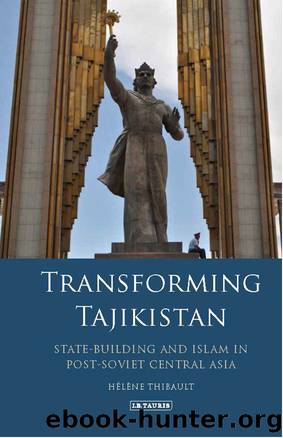Transforming Tajikistan: State-Building and Islam in Post-Soviet Central Asia by Helene Thibault

Author:Helene Thibault [Thibault, Helene]
Language: eng
Format: epub
Tags: International Relations, Communism; Post-Communism & Socialism, Modern, Political Ideologies, Social Science, 20th Century, Social History, Political Science, Islamic Studies, History, General
ISBN: 9781786733122
Google: sxOJDwAAQBAJ
Amazon: B07BHWG573
Goodreads: 40132131
Publisher: I.B.Tauris
Published: 2018-01-31T00:00:00+00:00
Assessing Religion
Cefaï asserts that, prior to starting research, scholars should only entertain a vague idea of what they will investigate during fieldwork, because the research topic properly speaking can only emerge through a process of familiarization with the milieu and people.7 If a complete absence of prejudices is perhaps desirable for a researcher, it is hardly achievable. Yanow explains that the ethnographer is âunderstood to bring prior knowledge to his or her experiences, thereby giving shape to the myriad sensate stimuli [â¦] vying for attention.â8 In Central Asia, assumptions about religious dynamics can lead researchers to overemphasize the prevalence of radical beliefs and conservative values. I myself was not wholly immune to that tendency. Prior to arriving in Tajikistan, I thought I would be confronted with two types of people â religious or secular â and that it would be easy to distinguish them. I expected that individuals and groups would express their faith in obvious ways. For instance, I was very much looking forward to attending a âreligious wedding,â which I expected to be a solemn religious experience. It turned out that there was not much religion involved in such a wedding except for the âNikoh,â during which the bride and the groom exchanged vows before God. The ceremony was not officiated by a religious authority, but rather by a respected elder relative. The Nikoh does not even require the presence of guests. Family and friends simply gather afterwards to celebrate the union in a reception hall or at someone's home. No alcohol is served, no music is played, and women and men sit in two separate rooms. The absence of alcohol and dancing is the primary difference between religious and secular marriages.
Another example is the observance of Ramadan, which I expected to be very solemn and contemplative. In July of 2010 I celebrated the first day of Ramadan sitting in an orchard with a bunch of men who, though they all identified as Muslims, did not scruple to make vodka toasts in celebration of the holy month. At the end of Ramadan, I accompanied a friend to visit her grandparents. Most people honour the end of Ramadan by visiting family elders and offering them presents. Someone said a short prayer, pronounced when we arrived (this was quite ordinary), and the conversation quickly turned to profane matters. Again, religious displays were not as prevalent as I expected them to be. I quickly realized that I needed to move past the religious-secular dichotomy in my thinking. Ethnographic immersion appeared to be the proper approach to investigate the region of overlap between religious and secular realms and to more subtly assess the meaning of behaviours that might seem obviously religious or secular. None of this is to say that categories are irrelevant, but rather to argue that they are primarily useful as starting points for understanding the complex dynamics of Tajik society. It will quickly become apparent in the case studies below why I needed to move beyond a rigid application of this duality.
Download
This site does not store any files on its server. We only index and link to content provided by other sites. Please contact the content providers to delete copyright contents if any and email us, we'll remove relevant links or contents immediately.
| Central Asia | Southeast Asia |
| China | Hong Kong |
| India | Japan |
| Korea | Pakistan |
| Philippines | Russia |
The Sympathizer by Viet Thanh Nguyen(4305)
The Rape of Nanking by Iris Chang(4136)
World without end by Ken Follett(3426)
Ants Among Elephants by Sujatha Gidla(3417)
Blood and Sand by Alex Von Tunzelmann(3138)
Japanese Design by Patricia J. Graham(3108)
City of Djinns: a year in Delhi by William Dalrymple(2513)
The Queen of Nothing by Holly Black(2491)
Foreign Devils on the Silk Road: The Search for the Lost Treasures of Central Asia by Peter Hopkirk(2432)
India's Ancient Past by R.S. Sharma(2414)
Inglorious Empire by Shashi Tharoor(2394)
Tokyo by Rob Goss(2388)
In Order to Live: A North Korean Girl's Journey to Freedom by Yeonmi Park(2344)
India's biggest cover-up by Dhar Anuj(2318)
Tokyo Geek's Guide: Manga, Anime, Gaming, Cosplay, Toys, Idols & More - The Ultimate Guide to Japan's Otaku Culture by Simone Gianni(2314)
The Great Game: On Secret Service in High Asia by Peter Hopkirk(2305)
Goodbye Madame Butterfly(2202)
Batik by Rudolf Smend(2123)
Living Silence in Burma by Christina Fink(2037)
